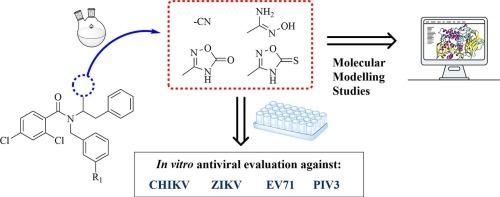携带羧酸生物同位体的苯丙氨酸衍生物对基孔肯雅病毒和3型副流感病毒的抗病毒活性
IF 3
3区 医学
Q2 BIOCHEMISTRY & MOLECULAR BIOLOGY
引用次数: 0
摘要
来自不同病毒科的致病性RNA病毒构成了重大的公共卫生危害。对大多数RNA病毒感染有效的特异性抗病毒药物尚未开发出来。在本研究中,目的是研究通过用腈、羟脒和5-氧/硫氧-1,2,4-恶二唑等多种生物异构体取代苯丙氨酸衍生物的羧酸部分而设计的广谱抗病毒活性。本研究组新合成的N-(1-取代2-苯乙基)-N-(3-氯苯基)-2,4-二氯苯酰胺类(6e、7e、8e和9d)及其苯丙氨酸衍生物对基孔肯雅病毒(CHIKV)、寨卡病毒(ZIKV)、副流感病毒3型(PIV3)和肠病毒71型(EV71)的抗病毒活性进行了评价。所有苯丙氨酸衍生物均显示出对PIV3的抗病毒活性,其中3-氟苯取代类似物6d是最有效的化合物(IC50 = 3.74 μM, CC50 >;100 μM),而3-氯苯类似物6e (IC50 = 5.72 μM, CC50 >;100 μM)具有最佳的抗病毒活性。结合分子对接和分子动力学(MD)模拟研究,分别预测化合物6d和6e与PIV3和CHIKV可能的病毒蛋白的相互作用。本文章由计算机程序翻译,如有差异,请以英文原文为准。

Antiviral activities of phenylalanine derivatives carrying carboxylic acid bioisosteres against chikungunya and parainfluenza virus type 3
Pathogenic RNA viruses from various virus families represent substantial public health hazards. Specific antiviral drugs effective against most RNA virus infections have not yet been developed. In this study, it was aimed to investigate the broad-spectrum antiviral activities of phenylalanine derivatives designed by replacing the carboxylic acid moiety with various bioisosteres such as nitrile, hydroxamidine and 5-oxo/thioxo-1,2,4-oxadiazole. Novel synthesized N-(1-substituted 2-phenylethyl)-N-(3-chlorobenzyl)-2,4-dichlorobenzamides (6e, 7e, 8e and 9d), together with phenylalanine derivatives previously prepared by our group, were evaluated antiviral activities against chikungunya (CHIKV), Zika (ZIKV), parainfluenza virus type 3 (PIV3), and enterovirus 71 (EV71). All phenylalanine derivatives showed antiviral activities against PIV3, with the 3-fluorobenzyl substituted analogue 6d emerging as the most potent compound (IC50 = 3.74 μM, CC50 > 100 μM), whereas the 3-chlorobenzyl analogue 6e (IC50 = 5.72 μM, CC50 > 100 μM) possessed the best non-toxic antiviral activity against CHIKV. Combined molecular docking and molecular dynamics (MD) simulation studies were conducted to predict the interactions of compounds 6d and 6e with the possible viral proteins of PIV3 and CHIKV, respectively.
求助全文
通过发布文献求助,成功后即可免费获取论文全文。
去求助
来源期刊

Bioorganic & Medicinal Chemistry
医学-生化与分子生物学
CiteScore
6.80
自引率
2.90%
发文量
413
审稿时长
17 days
期刊介绍:
Bioorganic & Medicinal Chemistry provides an international forum for the publication of full original research papers and critical reviews on molecular interactions in key biological targets such as receptors, channels, enzymes, nucleotides, lipids and saccharides.
The aim of the journal is to promote a better understanding at the molecular level of life processes, and living organisms, as well as the interaction of these with chemical agents. A special feature will be that colour illustrations will be reproduced at no charge to the author, provided that the Editor agrees that colour is essential to the information content of the illustration in question.
 求助内容:
求助内容: 应助结果提醒方式:
应助结果提醒方式:


